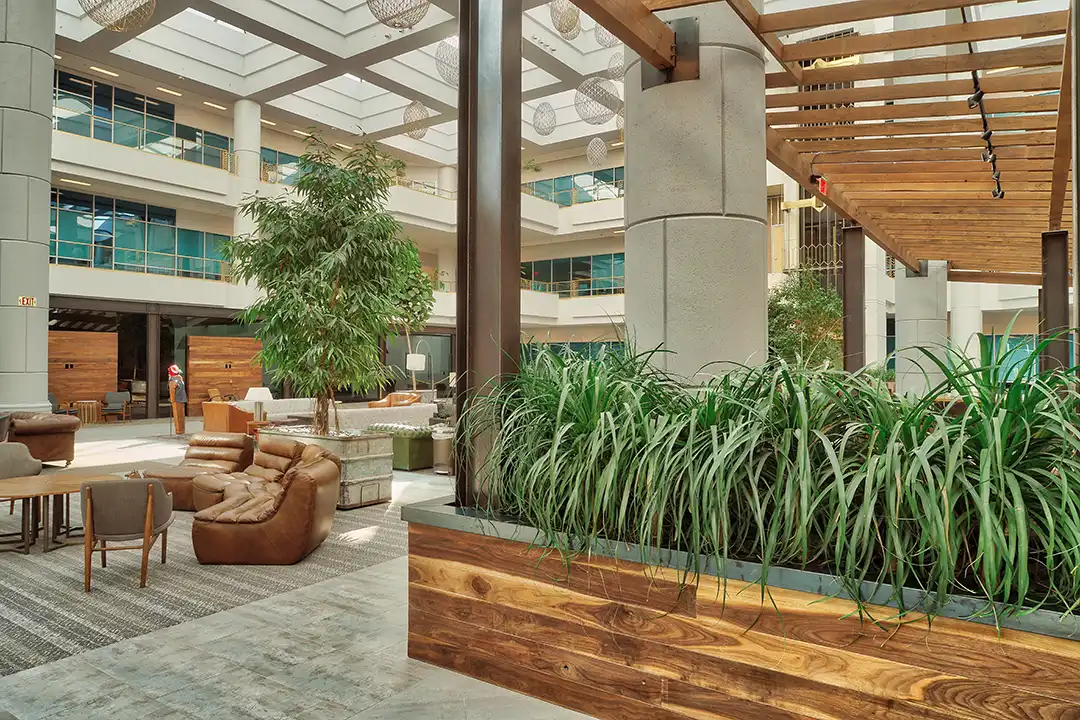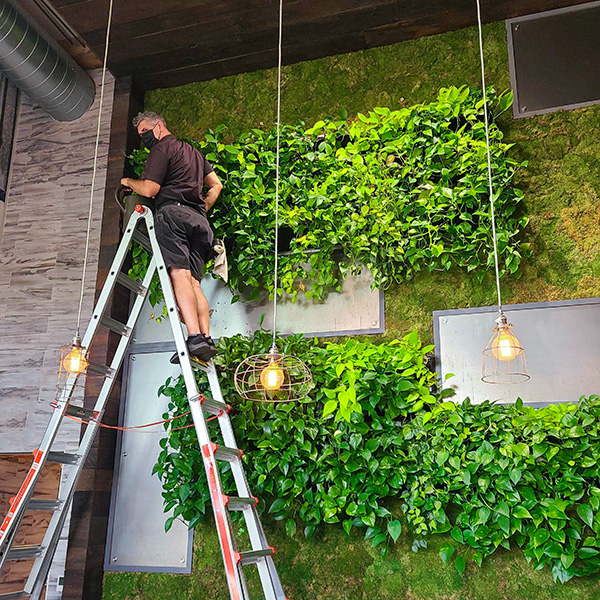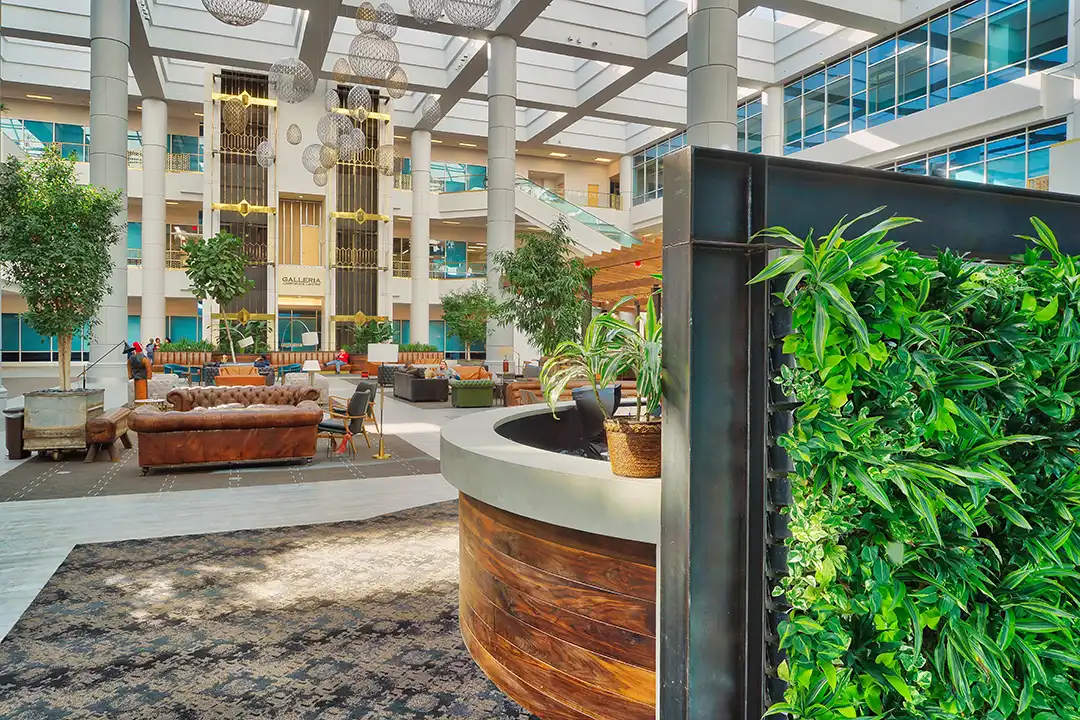
What is biophilic architecture?
Biophilic architecture, a trend revolutionizing modern building design, integrates natural elements to create spaces that promote health, happiness, and sustainability. The trend was gaining momentum pre-Covid, but is truly flourishing today, as people have a newfound appreciation for the great outdoors. Biophilic design, derived from the Greek origin meaning ‘a love of life or living things,’ integrates nature and natural elements into the world of architecture and urban development. In structural design, biophilia is known to make people happier, healthier, and more relaxed by adding natural surroundings such as indoor plants and water features, into their daily lives.
The history and evolution of biophilic architecture
The notion for biophilic design was first conveyed by well-known biologist E.O. Wilson in 1984. He explained the concept as the need for humans to surround themselves with the natural world within the confines of daily life. However, the signs of connecting building occupants more closely to the environment date as far back as the sixth century B.C with the Hanging Gardens of Babylon. Currently, this idea has spread globally from China to Milan and throughout the United States.
Bill Browning, founder of Terrapin Bright Green and one of the green building and real estate industry’s foremost thinkers and environmental strategists, says the pandemic has been the driving force of biophilic architecture’s rising popularity.

“People spend a lot more time in the same space and really desire more of a connection to nature,” said Browning. “They need something that supports their health and wellbeing, promotes stress reduction, and improves their cognitive performance. They want the boost that you get from experiencing Mother Nature.”
When scoping out a new building, Browning raises the question, “’Can we build and operate a structure that delivers the ecosystem that would’ve been here without the building?’” The biophilic expert says many are realizing that this connection to the outdoors is helpful and that there are ways of incorporating it into the landscape.
“Understanding mechanics of how our ecosystem works is crucial and I think to myself can I replicate this with the built environment?” says Browning. “I try to connect this with the construction itself.”
Browning adds that biophilic design and architecture is on the rise because more and more information is being published that helps people understand the science behind it and makes them want to be part of this green movement that can improve their lives.
For example, Stefano Boeri Architecture is working on its latest master project, Liuzhou Forest City. The blueprint offers a solution to one of China’s most smog-affected cities, as the infrastructure will be capable of absorbing up to 10,000 tons of CO2 every year. This groundbreaking design will sustain nearly 40,000 trees and 1 million plants from a varied selection of species. Furthermore, the city will accommodate over 30,000 people.
Browning says people are now asking themselves how they feel in every space they’re in, whether that be a hotel lobby, a working office, or their own home.
“People are starting to realize that there are things they can do to change how they feel within their chosen environment and make that connection to nature in any location.”
Examples of Biophilic Architecture in Practice
Big businesses are embracing the aspects of the natural world that contribute to human health and productivity including tech giants such as Google, Microsoft, and Amazon. These companies are elevating today’s notion of bringing the outdoors inside. For example, in Google’s Chicago office employees have autonomy to adjust the color temperature of the lighting to obtain a glow that replicates sunshine. Microsoft built meeting spaces twelve feet off the ground that look like treehouses and Amazon’s glass-paneled spheres encompass enormous living walls with hundreds of colorful plant species.
When it comes to hotels, many establishments find that incorporating natural elements into the hotel’s interiors helps reduce anxiety, delivers an oasis of peace, and makes guests feel safe and welcome. Between the greenery of plants and the calming sounds of trickling water, great strides are made in alleviating the feelings of nervous, overly tired visitors who are eager to soak up the outdoors after arriving at their destination. Big-name hotels like 1 Hotel West Hollywood and the PARKROYAL COLLECTION Pickering in Singapore surround guests with nature via environmental elements including sand, wood, rocks, water and living plants inside the venues. It is certain that biophilic enhancements play a crucial role in a hotel’s ability to keep guests returning time and time again by designing an overall guest experience of happiness and calming refuge.
As the concern for the climate grows more with each passing day, the principles of biophilic architecture and design prove to not only be useful for their calming aesthetic qualities but are also hypothesized to combat climate change. In fact, green infrastructure has the capability to decrease CO2 emissions and naturally improve the temperature of buildings.

Designing Spaces That Promote Health and Productivity
Many companies are turning to this concept as a part of their return to the office plan in an attempt to reinvent the workplace as we know it. Therefore, we can expect to see bright, naturally lit office areas accentuated with colors associated with the outdoors, such as blue, yellow, or green. A plethora of plants, greenery and plant walls will emerge, along with the sights and sounds of stones, branches and both wood and water features.
Regardless of where the practice of connecting people and nature within our built environments is being implemented, its future is brighter than ever. Browning adds that now more than ever, physical, and mental health are at the forefront of people’s thoughts and priorities.
“People are now asking themselves if the spaces they’re in are making them happy. A lot of people are realizing that they don’t want to be in a place that makes them feel sad or depressed, and that there are ways to change that and reconnect with nature for its benefits,” says Browning.
It is essential that businesses consider this factor when redesigning the workplace or for employees working remotely. Overall, a multisensory biophilic experience is proven to reduce stress, increase productivity and evoke feelings of happiness. So, as people begin redesigning their workplaces or homes, perhaps they should simply start by letting the outside in.
For more information on how Plant Solutions can help you design a space that creates a sense of harmony between modern architecture and the natural world, please click here.
Ready to incorporate biophilic design into your projects?
Contact Plant Solutions today to create a nature-inspired space!
